Chronic, episodic nicotine exposure alters GABAergic synaptic transmission to hypoglossal motor neurons and genioglossus muscle function at a critical developmental age
- PMID: 36350047
- PMCID: PMC9722256
- DOI: 10.1152/jn.00397.2022
Chronic, episodic nicotine exposure alters GABAergic synaptic transmission to hypoglossal motor neurons and genioglossus muscle function at a critical developmental age
Abstract
Regulation of GABAergic signaling through nicotinic acetylcholine receptor (nAChR) activation is critical for neuronal development. Here, we test the hypothesis that chronic episodic developmental nicotine exposure (eDNE) disrupts GABAergic signaling, leading to dysfunction of hypoglossal motor neurons (XIIMNs), which innervate the tongue muscles. We studied control and eDNE pups at two developmentally vulnerable age ranges: postnatal days (P)1-5 and P10-12. The amplitude and frequency of spontaneous and miniature inhibitory postsynaptic currents (sIPSCs, mIPSCs) at baseline were not altered by eDNE at either age. In contrast, eDNE increased GABAAR-α1 receptor expression on XIIMNs and, in the older group, the postsynaptic response to muscimol (GABAA receptor agonist). Activation of nAChRs with exogenous nicotine increased the frequency of GABAergic sIPSCs in control and eDNE neurons at P1-5. By P10-12, acute nicotine increased sIPSC frequency in eDNE but not control neurons. In vivo experiments showed that the breathing-related activation of tongue muscles, which are innervated by XIIMNs, is reduced at P10-12. This effect was partially mitigated by subcutaneous muscimol, but only in the eDNE pups. Taken together, these data indicate that eDNE alters GABAergic transmission to XIIMNs at a critical developmental age, and this is expressed as reduced breathing-related drive to XIIMNs in vivo.NEW & NOTEWORTHY Here, we provide a thorough assessment of the effects of nicotine exposure on GABAergic synaptic transmission, from the cellular to the systems level. This work makes significant advances in our understanding of the impact of nicotine exposure during development on GABAergic neurotransmission within the respiratory network and the potential role this plays in the excitatory/inhibitory imbalance that is thought to be an important mechanism underlying neonatal breathing disorders, including sudden infant death syndrome.
Keywords: GABA; development; hypoglossal; nicotine.
Conflict of interest statement
No conflicts of interest, financial or otherwise, are declared by the authors.
Figures

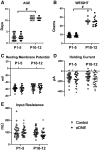

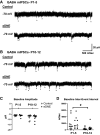
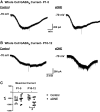
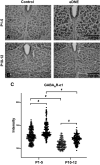
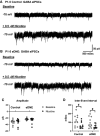
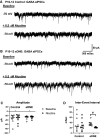

Similar articles
-
Developmental plasticity of GABAergic neurotransmission to brainstem motoneurons.J Physiol. 2018 Dec;596(23):5993-6008. doi: 10.1113/JP274923. Epub 2018 Feb 25. J Physiol. 2018. PMID: 29352468 Free PMC article.
-
Chronic, Episodic Nicotine Alters Hypoglossal Motor Neuron Function at a Critical Developmental Time Point in Neonatal Rats.eNeuro. 2021 Aug 13;8(4):ENEURO.0203-21.2021. doi: 10.1523/ENEURO.0203-21.2021. Print 2021 Jul-Aug. eNeuro. 2021. PMID: 34193508 Free PMC article.
-
Developmental nicotine exposure alters glycinergic neurotransmission to hypoglossal motoneurons in neonatal rats.J Neurophysiol. 2018 Sep 1;120(3):1135-1142. doi: 10.1152/jn.00600.2017. Epub 2018 May 30. J Neurophysiol. 2018. PMID: 29847237 Free PMC article.
-
Developmental Nicotine Exposure Alters Synaptic Input to Hypoglossal Motoneurons and Is Associated with Altered Function of Upper Airway Muscles.eNeuro. 2019 Nov 15;6(6):ENEURO.0299-19.2019. doi: 10.1523/ENEURO.0299-19.2019. Print 2019 Nov/Dec. eNeuro. 2019. PMID: 31712219 Free PMC article.
-
Prenatal nicotine exposure and development of nicotinic and fast amino acid-mediated neurotransmission in the control of breathing.Respir Physiol Neurobiol. 2008 Dec 10;164(1-2):80-6. doi: 10.1016/j.resp.2008.05.008. Respir Physiol Neurobiol. 2008. PMID: 18585984 Free PMC article. Review.
Cited by
-
Cholinergic modulation of upper airway control: maturational changes and mechanisms at cellular and synaptic levels.J Neurophysiol. 2025 Jan 1;133(1):46-59. doi: 10.1152/jn.00165.2024. Epub 2024 Nov 28. J Neurophysiol. 2025. PMID: 39607299 Free PMC article. Review.
References
Publication types
MeSH terms
Substances
Grants and funding
LinkOut - more resources
Full Text Sources

